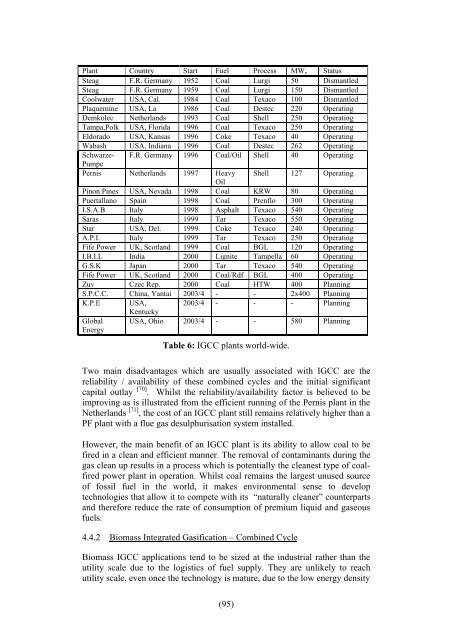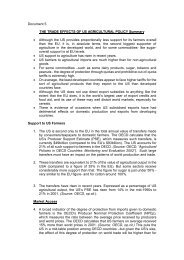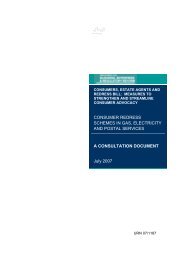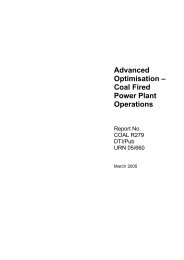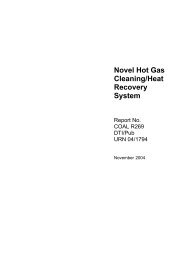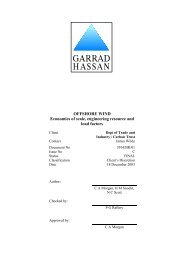(70) Therefore, the risk of sulphuric acid dew point attack ... - DTI Home
(70) Therefore, the risk of sulphuric acid dew point attack ... - DTI Home
(70) Therefore, the risk of sulphuric acid dew point attack ... - DTI Home
Create successful ePaper yourself
Turn your PDF publications into a flip-book with our unique Google optimized e-Paper software.
Plant Country Start Fuel Process MWe Status<br />
Steag F.R. Germany 1952 Coal Lurgi 50 Dismantled<br />
Steag F.R. Germany 1959 Coal Lurgi 150 Dismantled<br />
Coolwater USA, Cal. 1984 Coal Texaco 100 Dismantled<br />
Plaquemine USA, La 1986 Coal Destec 220 Operating<br />
Demkolec Ne<strong>the</strong>rlands 1993 Coal Shell 250 Operating<br />
Tampa,Polk USA, Florida 1996 Coal Texaco 250 Operating<br />
Eldorado USA, Kansas 1996 Coke Texaco 40 Operating<br />
Wabash USA, Indiana 1996 Coal Destec 262 Operating<br />
Schwarze-<br />
Pumpe<br />
F.R. Germany 1996 Coal/Oil Shell 40 Operating<br />
Pernis Ne<strong>the</strong>rlands 1997 Heavy Shell 127 Operating<br />
Oil<br />
Pinon Pines USA, Nevada 1998 Coal KRW 80 Operating<br />
Puertallano Spain 1998 Coal Prenflo 300 Operating<br />
I.S.A.B Italy 1998 Asphalt Texaco 540 Operating<br />
Saras Italy 1999 Tar Texaco 550 Operating<br />
Star USA, Del. 1999 Coke Texaco 240 Operating<br />
A.P.I. Italy 1999 Tar Texaco 250 Operating<br />
Fife Power UK, Scotland 1999 Coal BGL 120 Operating<br />
I.B.I.L India 2000 Lignite Tampella 60 Operating<br />
G.S.K Japan 2000 Tar Texaco 540 Operating<br />
Fife Power UK, Scotland 2000 Coal/Rdf BGL 400 Operating<br />
Zuv Czec Rep. 2000 Coal HTW 400 Planning<br />
S.P.C.C. China, Yantai 2003/4 - - 2x400 Planning<br />
K.P.E USA, 2003/4 - - - Planning<br />
Global<br />
Energy<br />
Kentucky<br />
USA, Ohio 2003/4 - - 580 Planning<br />
Table 6: IGCC plants world-wide.<br />
Two main disadvantages which are usually associated with IGCC are <strong>the</strong><br />
reliability / availability <strong>of</strong> <strong>the</strong>se combined cycles and <strong>the</strong> initial significant<br />
capital outlay [<strong>70</strong>] . Whilst <strong>the</strong> reliability/availability factor is believed to be<br />
improving as is illustrated from <strong>the</strong> efficient running <strong>of</strong> <strong>the</strong> Pernis plant in <strong>the</strong><br />
Ne<strong>the</strong>rlands [71] , <strong>the</strong> cost <strong>of</strong> an IGCC plant still remains relatively higher than a<br />
PF plant with a flue gas desulphurisation system installed.<br />
However, <strong>the</strong> main benefit <strong>of</strong> an IGCC plant is its ability to allow coal to be<br />
fired in a clean and efficient manner. The removal <strong>of</strong> contaminants during <strong>the</strong><br />
gas clean up results in a process which is potentially <strong>the</strong> cleanest type <strong>of</strong> coalfired<br />
power plant in operation. Whilst coal remains <strong>the</strong> largest unused source<br />
<strong>of</strong> fossil fuel in <strong>the</strong> world, it makes environmental sense to develop<br />
technologies that allow it to compete with its “naturally cleaner” counterparts<br />
and <strong>the</strong>refore reduce <strong>the</strong> rate <strong>of</strong> consumption <strong>of</strong> premium liquid and gaseous<br />
fuels.<br />
4.4.2 Biomass Integrated Gasification – Combined Cycle<br />
Biomass IGCC applications tend to be sized at <strong>the</strong> industrial ra<strong>the</strong>r than <strong>the</strong><br />
utility scale due to <strong>the</strong> logistics <strong>of</strong> fuel supply. They are unlikely to reach<br />
utility scale, even once <strong>the</strong> technology is mature, due to <strong>the</strong> low energy density<br />
(95)


